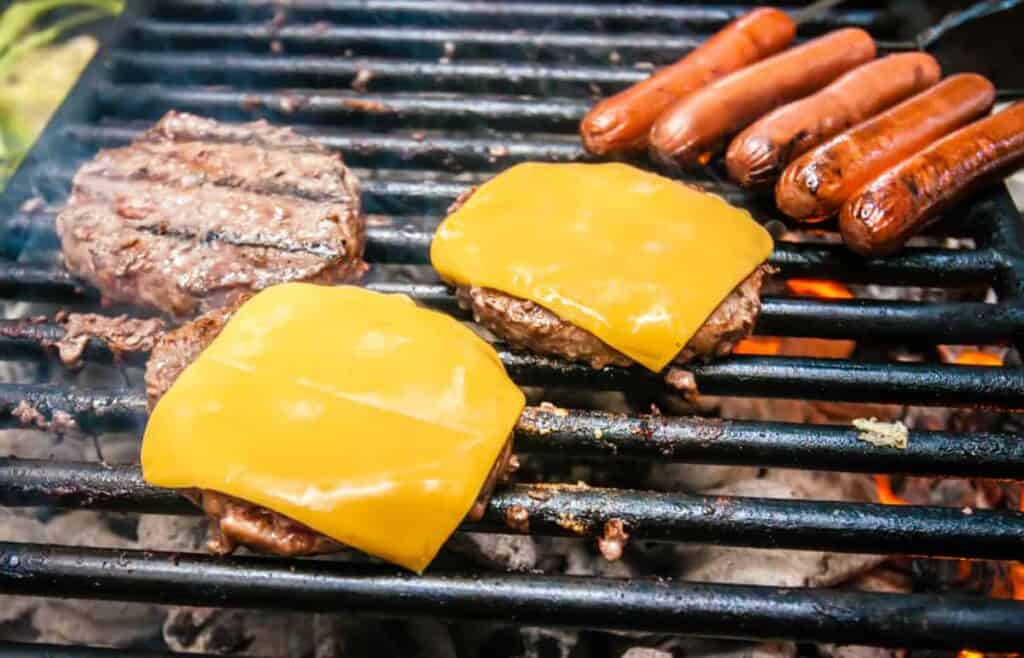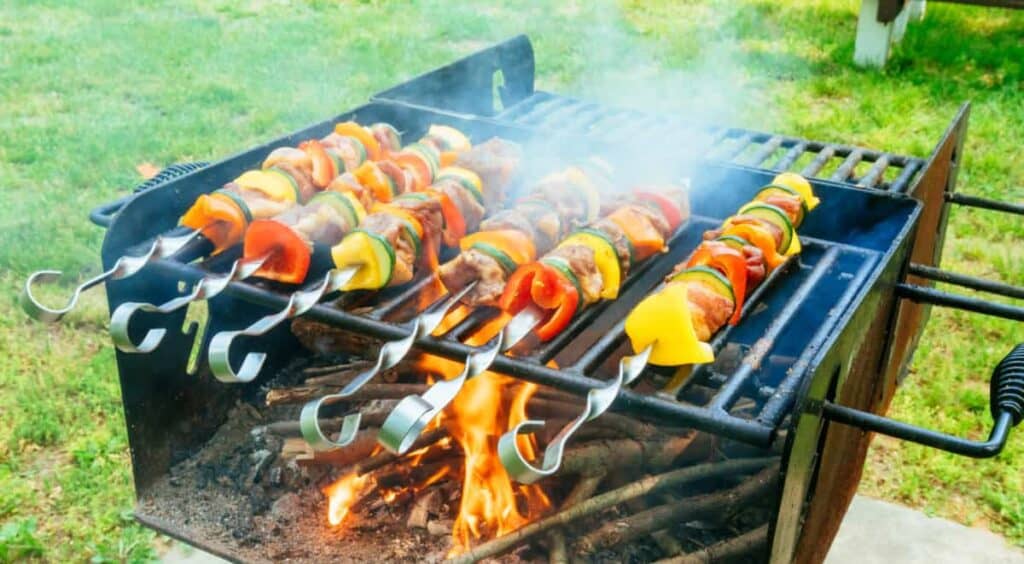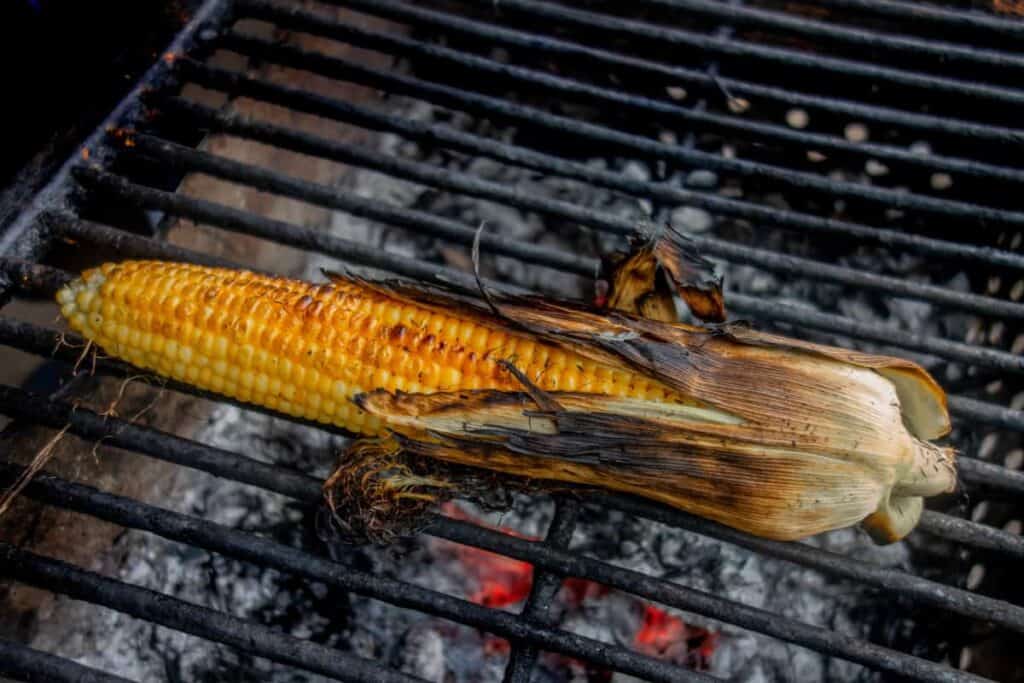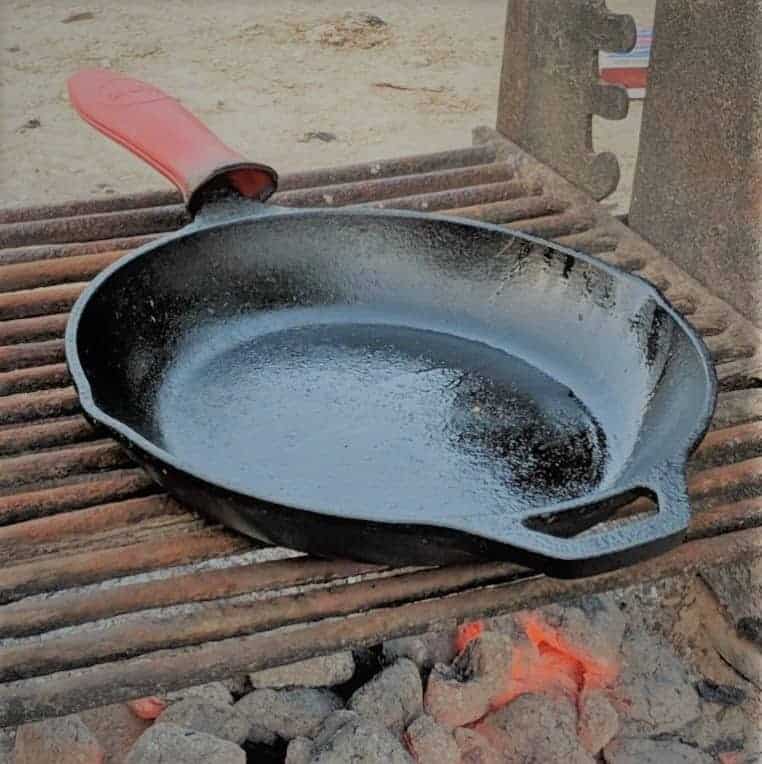There’s just something special about sitting around a fire with your mates. Picture a slab of choice meat you picked up at the supermarket earlier being grilled to perfection on the fire you just build from scratch, and you look up to see the palette of the night sky changing from honey yellow to a darker mixture of purples, blues, and even greens. You won’t soon forget this moment.

Grilling at a campsite or at a primitive site doesn’t have to be complicated or unreachable for most would-be camping chefs. All you truly need is fire, a portable grill-grate, and something to cook. Besides those few essential things, you have a good amount of room for creativity depending on your preferences and abilities.
My goal is to give you a starting point to find easy and fun grilling recipes while camping. Not everything you can grill is good for camping, so I tried to find the most convenient options. Enjoy!
By the way, as an Amazon Associate, I earn when buying qualified products through links on my site.
What to Grill When Camping
Just because you’re camping doesn’t mean you have to eat hot dogs and marshmallows on a stick! There are so many easy grilling possibilities that aren’t complicated.
The following list are foods that are easy. Pinterest recipes are one thing, but it’s quite another to actually truck out all those ingredients to a campsite. Chopping and food prep is not exactly convenient when camping, especially if you’re backpacking! So I’ll stick to recipes that have as little prep as possible.
Hot Dogs
Okay, I just told you there is more to life when camping than hot dogs. However, there is more to be discovered with hot dogs! Hot dogs are going to taste better grilled than any other cooking method (science hasn’t caught up and explained why fully), especially when you’re camping.

To be frank (ha! I’m on a roll today!), hot dogs are a go-to grilling option while camping.
If you want to take your hot dogs to the next level there are tons of things you can do with them and foods that complement them that work for camping. Check out our article on this subject to level-up your camping hot dogs.
When grilling hot dogs: Remember to keep the hot dogs perpendicular and not parallel to the grill. Some of those camping grills are pretty wide in between the bars, and you don’t want to lose the precious hot dog to ashes.
Hamburgers
Ahh… hamburgers… another of one of the most popular grilling options.
Hamburgers are a very easy meal to grill while camping. All you have to prep are the toppings and the meat itself.
Pro-tip: If you are eating hamburgers while camping, do ALL the prep at home. Hamburger meat isn’t safe to handle until cooked, and because by nature it’s a little messy, it’s not easy to keep a sanitary kitchen with hamburger meat, even when car camping. Season and prepare your patties at home so that when you come to the campsite, you can just slap them onto the grill.
The same goes for any toppings. Putting all of your toppings and dressings in small containers (tupperware to the rescue) at home will make cooking hamburgers much easier.
When grilling hamburgers, use a hot fire (can’t hold your hand 5 inches above the grill for more than 3-5 seconds)–the hamburgers are ready to flip when the juice from the hamburger is pooling on top of the patty.
Steak
Depending on how serious a steak master you are, cooking steak can be complex or very simple. Do you need fancy marinades? Or does salt and pepper get you all you need?
Either way, steak tastes best when you’ve been outside hiking all day.
The less bones the better. Choosing a cut of steak with as little leftover parts as possible is ideal. Even when car camping, you don’t want to deal with bones and if you’re backpacking, you especially don’t want to since you would have to carry those bones out.
For reference, here are a list of steak cuts with bone or lots of sinew:
- T-Bone
- Porterhouse
- Tomahawk
- Flat Iron (before being cut, has a large strip of sinew, your steak may vary)
- Ribeye (sometimes bone-in, called technically a rib steak, or tomahawk)
- Flat-bone sirloin
- Round-bone sirloin
These steaks might require more work and might leave meat scraps behind, which is not as desirable when camping, especially if you are not near a secure disposal site so you don’t attract animals.
When grilling steak: If you’re going to be hiking all day to your campsite, freeze the steaks and wrap in insulation so by the time you get to your destination, your steak will be ready to eat. Be careful to not let the steak get too warm as you may risk bacteria getting into your food.
When marinading your steak: Make sure and do all the marinading before you get to the campsite to make it easier for yourself
Bring a meat thermometer if you are planning on cooking the steak with some pink so you can get to a safe temperature. You’re not in a clean cooking environment so you might cook things a bit more than you usually do.
Chicken
Chicken has some of the same problems of steak in that many parts of the chicken are “bone-in” which can be a pain to deal with while camping.
So, if you are choosing a part of the chicken to grill while camping: Chicken breasts make for an easy option!
This recipe from delish.com suggests a brown sugar marinade with balsamic vinegar with Italian seasoning.
When grilling chicken: Make sure to keep your chicken below 40 degrees Fahrenheit if you can. Bacteria loves to grow between 40 degrees and 140 degrees Fahrenheit (source). Bring a cooler with ice.
When marinading your chicken: Make sure and do all the marinading before you get to the campsite to make it easier for yourself.
Shish Kebabs
A fun and incredibly easy to grill option for camping. If you pre-prepare your Shish Kebabs ahead of time, all you have to do is put them on the grill and rotate them as needed!

Shish Kebabs make it easy and convenient to cook meats that generally would be more difficult to grill, such as shrimp. Beef, lamb, chicken, pork, fish–all are possible with shish kebabs.
There is a bit of an art to it, though. For camping, you may have a very hot fire, and so if you are using wooden skewers, make sure you soak them so the skewers don’t burn. Another hack is to place aluminum foil underneath the handle of the wooden skewer.
Additionally, you want to make sure and use vegetables that have similar cooking times as your meat. This is tricky to do! An easier method is to cook your meat and vegetables on separate kebabs. They may not look as colorful, but you will have more consistently cooked food.
If you want more ideas of what kinds of fruits and vegetables to skewer along with your meat, check out FoodandWine.com’s excellent article here.
Grilled Corn
Corn is a super easy food to grill with one huge downside for camping–the leftover cobs and husks. If your campsite is established, you may have the luck to have dumpsters that the campground manages. In some states and camping locations, you won’t be that lucky and you have to pack out all your trash yourself.

If you do have a way to get rid of the cobs (burning them is not a good idea. These are packed with moisture and will be difficult to burn and will invite rodents like nobody’s business. Or rather, they will be in everybody’s business), then these are a delicious grilling meal.
When grilling corn: Many people choose to grill the corn with the husks pre-soaked in water. Some recipes instruct you to put butter under the husks against the corn, and others instruct you to put the corn directly on the grill. There’s no real wrong way to do this, it all depends on your taste and preference!
In Southeast Texas where we live, it’s very common to see Parmesan cheese, chili powder, lemon pepper, butter, and salt and pepper as toppings for your corn. In fact, you can put all of these on and it will be a fiesta in your mouth.
Grilled Fish
Salmon, bass, or even trout all taste better when you’re camping. I admit, I’m not a huge fish fan, but I’ve had some delicious fish when they’re cooked over an open fire. Maybe it was because I had done a lot of hiking and was really hungry.
Filets would be difficult to grill since they fall apart easily. Grilling the entire fish is more of a possibility
Grilled Bread
Imagine you’re at a campsite with your friends, and most of the meal has been prepared, when you pull out some french bread that has been pre-buttered and garlic’d. Garlic bread with those gorgeous grill marks may be one of the most appetizing things.
You’ll have lots of friends, for sure, if you grill up some garlic bread.
Other Foods Great for Grilling While Camping
Here are a list of ideas in less detail:
- Pineapple: If you haven’t tried grilled pineapple, you haven’t lived! I recommend slicing the pineapple into rings to make them easier to grill at home so you don’t have to deal with cutting a pineapple at the campsite. I also recommend a vegetable grilling basket
- Vegetables including onions, bell peppers, cauliflower, broccoli, zucchini, carrots. Use a vegetable grilling basket to not lose your vegetables
- Sweet Potatoes: If you skin the sweet potatoes and cut them into thinner strips, you can easily grill the sweet potatoes with a bit of oil on the potatoes
- Asparagus: with some Parmesan cheese, oil, salt and pepper, Asparagus is a fantastic grilling option
- Shrimp: Shrimp need a basket or need to be skewered, but shrimp can taste great when grilled on an open fire.
- Bacon: Bacon can be wrapped around almost anything and grilled. Toothpick skewers are helpful to keep your bacon attached to your food.
Grilling Meals for Camping
With all the knowledge you have just learned above, many meals open up as possibilities. Here are some ideas:
- Fajitas: If you want to cook your meat on the grill, you may have to wait till after the meat is cooked before cutting the meat into strips. The other option is to use your trusty cast iron pan to cook your meat on the grill. Or, you can construct a fajita with your shish kebab results
- Tacos: Whether you’re grilling chicken breasts or chicken thighs, or beef strips, these will make for amazing tacos
- Bacon-Wrapped Filet Mignon: Using toothpicks, wrap the bacon around the filets. Grill over a medium heat to ensure you cook through the meat
- Chicken Quesadillas: Utilizing that grilled chicken, you can cut it into strips and put in between two quesadillas, cheese, and some beans of your choice… what do you get? a delicious camping meal you’ll remember!
Is it Safe to Use a Rusty Grill?
When you go camping at an established campground, they will most likely have a permanent firepit. These firepits sometimes have grills or grates that can be used for cooking–these grates are out in the sun and rain every day, and so they tend to get quite rusty.

You have several options here:
- Do nothing: If the grate is only slightly rusty, then just eat the rust that gets onto the food. Rust is simply Iron oxide, and is mostly inert, and our bodies don’t digest it but just pass it through our systems. There isn’t any data out there for people being harmed from eating rust. That being said, it’s probably best to do some cleanup before starting. Always heat the grate first before putting food on it.
- Heat the grate and then scrub off the grate with a metal brush. Try not to inhale during this process because that rusty powder will fly a bit. Let the fire die down a bit and then put a little bit of oil on a paper towel and wipe down the grill grates–this will clean up a decent portion of that powder.
- Use other cookware on top of the grate. You might miss out on those grill marks but your food will still taste great. If you’re looking for a pan that can withstand high temperatures, checkout our favorite camping cookware here.
- Use your own grill grate. A popular option is to use your own portable grill grate over the fire. You can store this in your garage when not using it. Some of these are painted and aren’t meant to be cooked directly on, but others are.
How to Grill While Camping
Cooking over a campfire is a different experience than cooking on a kitchen stove–we wrote a guide about this, which includes different fire configurations which makes it easier to cook. Check it out here.
Now that your adventurous spirit is piqued and your salivary glands are set off like Pavlov just rang a bell, let’s get down to how to achieve this wonderful experience. Whether you are at a campground with plenty of amenities, or you are at a primitive campsite with nothing but twigs and a fire pit, there are ways to get what you want! First, we will talk about how we are able to cook at a Campground, and then we will move on to discuss how cooking can be replicated at a primitive campsite.
Campground
Whether the campground policy is first-come, first-serve, or you need to reserve the space ahead of time, these are great campgrounds for you and your family to pull into with your car and get set up right away. These are normally fairly cheap, somewhere between $10-20 a night; MUCH better than any Airbnb I know of. Depending on what type of campground you choose, you will at least have a firepit, some sort of grill grate, and even a power source if you opt for such a thing. This is an easy place to cook, and since you can easily access the site with your car you are able to bring things such as perishable meats and fruits, a delicacy in the Great Outdoors.
PERKS OF CAMPGROUND GRILLING
- Easier to do than Primitive camping
- Wider variety of foods to make
- Easier access to proper cooking equipment
- Less worry for animals
- Easier to freeze and “keep” food
Backcountry/Primitive Camping
Here is where you need to take your time and plan out what exactly you are bringing with you. It’s more difficult this way to cook things such as meats and fruits because they will start to stink and you will definitely start to attract animals; and in some areas, bears. That is a big no-no. You will not be able to “grill” while backcountry camping like you would at a campground, but you can still cook a few wonderful dishes. We will discuss these later on. Lastly, you should bring a miniature grill-grate, at least 3 ways to make a fire (matches, cotton balls, lighter, flint/steel, etc.), and the food you want to cook.
PERKS OF BACKCOUNTRY/PRIMITIVE GRILLING
- More rustic feel
- More impressive when you are with your friends
- A deeper connection with nature
Why You Should Grill When You go Camping
Imagine the following scenarios:
First Story:
You are by yourself on a weekend trip through the Smoky Mountains, hiking with your 40 Liter Osprey Backpack with only the essentials. You hike out a few miles from the Alum Cave trailhead for the second day of your trip because your buddy Jared told you it was a beautiful trip with some really cool geological features along the way. It’s only a 5-mile roundtrip, so you take your time rounding the rock faces and enjoy the sights, the sounds, the smells.
You hike back to your spot at Walker Camp at around 5 PM and you figure its a good time to eat, exhausted from the second hike of the day. You find your designated stove and start up the fire. As you wait for your fire to burn more intensely, you pull out from your car a sealed package of steak from your cooler and begin seasoning it and cutting it up to get ready to cook. You have your veggies ready to boil in your pot of water resting on the grill-grate above the fire and throw them in. You finish with cooking and grab a plate and the book you are reading on this trip, “On The Road”, by Jack Kerouac. The sun is cooling and you enjoy your well-deserved meal.
Second Story:
You and your five mates hike out 5 miles across the snowy trails of the Canadian Rockies around Jasper National Park in April. The altitude keeps the air thin and the snow from melting, so you have to do your best to keep your breath as you trudge through the snow and ice. But you still have to keep up the pace because you are still a mile from your site and the sun will set within the hour. Exhausted and cold, but encouraged and joyful, you make it to your site with your buddies with about a half-hour of sunlight left.
Working quickly, you gather dead sticks that haven’t touched the ground yet and lay them with care in the designated fire location at your primitive site. You work hard to make sure the embers are handled with care as your exhausted and frozen fingers keep on working. You get the fire going after many prayers and reap the benefits. Your friend pulls out the most beautiful thing you have ever seen: a package of seasoned rice and pre-cut, seasoned chicken breast. You get your light-weight pan as your other friend pulls out their foldable pot and fix up the grill-grate that your last friend was carrying. The meal is served and you stare in awe at the simple beauty before you.
That steak at the Alum Cave trailhead and those chicken breasts in the middle of the Jasper wilderness will always be remembered as the most delicious and rewarding meals you have ever had, and in different circumstances, you would never be able to recreate them.
That is why grilling while camping is better than grilling otherwise.
Conclusion
There are plenty of other recipes you can try out for your next camping trip, so please do some more research of your own and try them out. Whether you go camping in a campground or in a backcountry site, there are plenty of ways to cook exactly what you want to cook. Remember to consider the LNT principles when you are planning out your trip, and be considerate of your environment when you are in the wild.
Grilling and cooking in the wild is an experience like no other, and it is my hope that these tips and recipes can help you make that experience happen.

